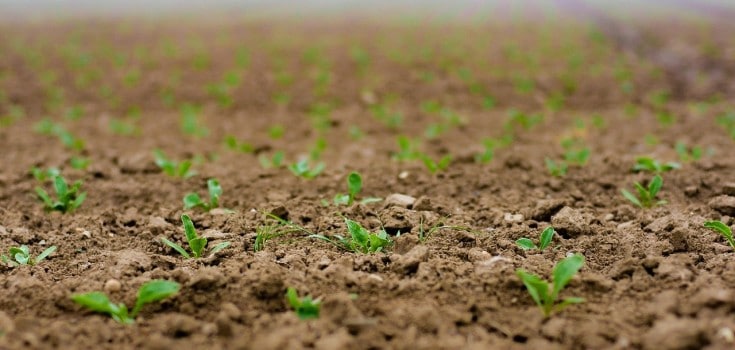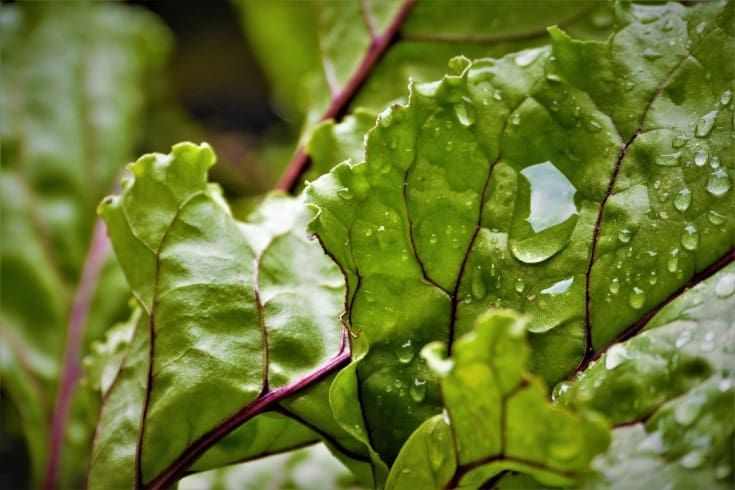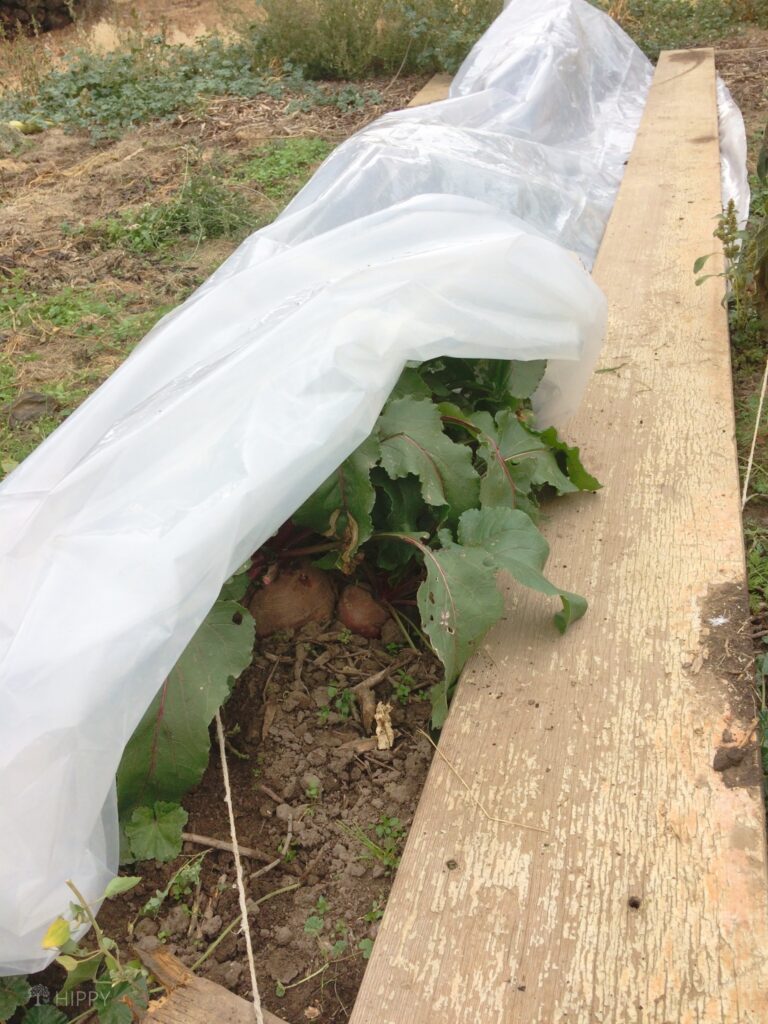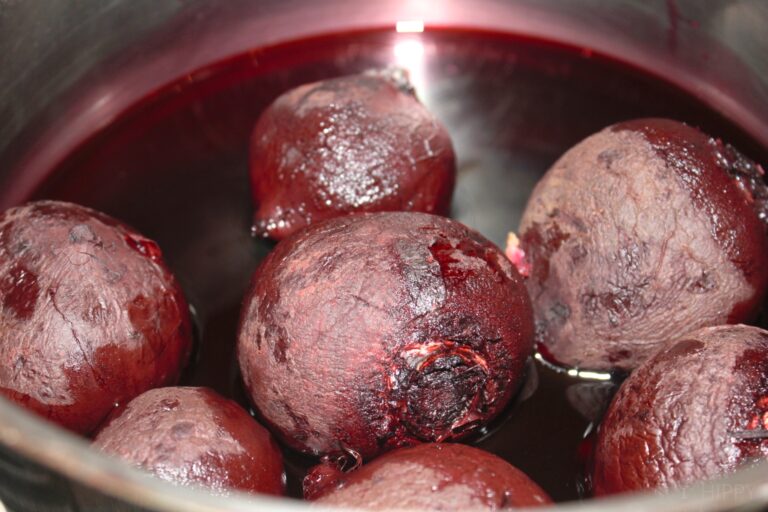Tender and with a distinctive taste of the earth beetroot (beta vulgaris) is worth growing for it’s high calorie content – 186 calories per pound.
It is one of the top 10 vegetables with high calorie content that you can easily grow from seed in most zones in the US., and this article will show you how.
Beetroot also has significant amounts of potassium, magnesium, vitamin C and vitamin B6. A 3.5-ounce (100g) serving also contains 11% of the average person’s daily requirement of dietary fiber.
Table of Contents
Beetroot Varieties
Here you will find many different varieties, including heirloom types, non GMO seeds, and varieties with an 85% germination rate listed. Chioggia, Golden Detroit, and Opalski, are just some of the beet types available.
Think about planting a Rainbow of beets with a kaleidoscope of beet seed featuring the familiar dark red, plus orange, golden and white beetroot as well as one that is pink and white candy striped on the inside.
It will certainly make pulling beets more fun as you wait to see what color you have and add interest to a platter of roasted vegetables!
The popular Detroit Dark beet with its pleasant globe shape and its ability to survive temperatures down to 25 Fahrenheit (-4 Celsius). The plants grow 16 inches tall, and when harvested the beet is up to 3 inches across.
If you like a really dark Heirloom beet, then try Bull’s Blood.
Soil
They need a loose well-drained soil to allow those beets to grow big, with a pH of 6 to 6.8, meaning a neutral to alkaline soil for optimal growth.
To ensure you have the right soil pH you can buy the Sonkir Reusable soil pH meter. It is reusable and doesn’t need batteries, or you can stick to time-tested paper strips.
Once you are sure of your soil pH then you will need to look at fertilizing as beetroot plants are heavy feeders and need lots of organic matter worked into the soil.
They also need fertilizer containing a balance of potassium for development of the beet, phosphorus for root growth and some nitrogen for leaf development and efficient photosynthesis.
Don’t use too much nitrogen, otherwise you have too much leaf development and not enough going into the root. Ask your nurseryman for recommendations for a good beet fertilizer.
When to Plant Beets
Beet will grow all year but if you plant near the warmest part of summer the plants will tend to bolt rather than producing good beetroot.
Also, don’t sow too early in the season otherwise they take a long time to grow and the beetroot can be hard and woody.
The soil temperature should be at least 40 to 50 Fahrenheit (4 to 10 Celsius) before planting beets. Beet will grow in USDA zones from 3 all the way through to 12. Wait until the weather warms up nicely then plant them in a position that gets full sun.
Stagger your planting times so you always have tender fresh beets as they mature in 50 to 70 days. To get a head start plant in seed trays or paper pots indoors.

How to Plant
Soaking the seed in lukewarm water for around 30 minutes or more before planting will help speed up germination.
Planting Straight Into the Ground
When planting, dig a groove along the row about 1 inch deep and place your beet seeds 4 inches apart, with the rows 12 inches apart. When they start to grow thin out the beets so they have place to expand into round globe shapes.
Each seed you plant is really a little cluster and you will get 2 to 4 plants from each seed – hence the need for thinning.
When thinning beets nip off the top with your fingers instead of pulling out the unwanted plants – otherwise you risk disturbing the roots of the ones you want to keep.
Planting in Pots
If you have a sunny balcony or a small backyard you can even grow your beet in pots. The pots should be at least 8 inches deep and should be a minimum of 8 inches in diameter.
Fill the pots with a general compost or potting soil to within 1/2 inch of the top. Tap the pot to settle the soil and water it then sprinkle 5 to 6 beet seeds onto the surface and cover with another ½ inch of compost/potting soil. Water again.
When the seedlings pop through wait until they are about 2 inches high before thinning out – remember each beet needs around 2-3 inches to grow to full size.
Transplanting From Seed Trays
If you want an early start you can plant in seed trays. Use seed compost, which is finer than the usual compost and stick a pencil or similar size twig into each individual compartment to a depth of ½ inch and push one seed in.
Cover with compost and make sure they are kept moist and within 2 weeks the plants will have germinated. Plant them outdoors 2 to 3 weeks after germination, when they have their second set of leaves.
Also don’t tamp the soil down too hard around the top of the plant once you plant your seed plugs – make sure the roots, however, are covered firmly with soil.
Planting for Beet Greens Rather Than Beetroot
If you are interested in the beet leaves only then stagger planting every two weeks and sow seed as advised in our How to plant section but you won’t need to worry about thinning out as you don’t need to give the roots that much space.
Try these varieties for best results for beet greens: Green Top Bunching and Crosby’s Egyptian. Fresh greens can be used in salads, whereas the older leaves should be cooked and used in soups, stews and quiches.
Planting Beet Tops
If you cut the top third off a harvested beetroot and place it in water the leaves will continue growing and you can keep harvesting beet greens for a while. Just remember to change the water every few days.
If you plant the top third in soil after dipping it in hormone rooting powder it may grow another beetroot. These do seem a long way round instead of just planting fresh seed however.
How Many Should I Plant?
Sow about 60 beets for a family of four so you can enjoy fresh beet and preserve some for winter use. The tops of the young beets can also be picked to add to salads.

Watering
Keep beets well watered during the early growing period while they are germinating and sending up their leaves so they grow quickly, but do not let the soil get waterlogged.
Once the beets are established keep soil just moist because if you overwater at this stage they may bolt – flowering and setting seed instead of directing the energy of the plant to creating a strong root system.

Diseases and Pests
Circular leaf spot (Cercospora beticola) is the most common fungal pathogen for beetroot – it survives in residue from crops, on certain weeds and seeds and can survive in the soil for up to 2 years.
The fungus makes pale brown spots on leaves with a red margin on the outer side, and the spots are off white towards the center.
To avoid this prliferating make sure any crop residue is thoroughly buried, and that the plants are not left wet overnight.
If irrigating, do it at midday so the leaves have time to dry out before dark, or use drip irrigation to avoid overly wetting the leaves.
Always buy certified disease free seed, and rotate crops making sure the beet is not rotated with Swish chard or spinach, which are also vulnerable to circular leaf spot.
Cutworm is problematic in that you don’t see it until the damage is done so if you have had previous problems with cutworm then rather be safe and spray the area as soon as you have planted with a pyrethroid and again after 10 to 12 days just before the seedlings emerge.
Leaf Miner is a small fly that lays its eggs on the beetroot leaves. Once hatched the larvae bore through the leaf, damaging the plant and leaving trails.
The most effective and natural method is to use parasitic wasps to will sort out the pest. Hopefully they procreate and you never have leaf miner problems again!
Spraying with insecticide will, however, kill off these beneficial wasps, so be careful in crop management.
Powdery Mildew. Look for small white blobs on the underside of the older leaves. This fungal infection is common to beetroot and chard. To avoid water early in the morning so the leaves have time to dry out.
While unsightly it doesn’t really affect the beetroot itself. You can control with an appropriate fungicide if the powdery mildew is widespread.
Crop Rotation
After planting a heavy feeder like beetroot plant legumes next – beans, peas, chickpeas – which are nitrogen fixers, to restore the soil.
Do not plant spinach or Swiss chard as they are heavy feeders and subject to circular leaf spot – if you have had an infestation you want to avoid it getting a hold again.
Harvesting
You can either pull your beets by grasping the beet leaves near the root and tugging gently if the soil is soft, or you can dig them out.
Once in your kitchen twist the leaves off about 2 inches from the root as otherwise the leaves take the moisture from the root; if you chop them too close the color bleeds out from the beet. Also, don’t trim the bottom part of the root.
Harvesting Beet Greens
If you are harvesting for beet greens then take the outer leaves. Always leave 2 to 4 of the inner leaves at the crown of the plant to provide the nourishment for the root to keep growing.
Harvest beet greens when they are around 6 inches high and most tender.
Storing Beetroot
You can store fresh beet for around 10 days in the refrigerator. You can boil beet whole then grate, slice or cube, and dress with vinegar, so you have beet in the refrigerator ready to add to salads or other dishes where it will last for 10 days or more. The other options are canning and preserving.

When freezing freshly boiled beet make sure to peel them before freezing – the skins slip off really easily when they are still warm.
Either cut into pieces or pack whole beets tightly into a container so there is no air in between and freeze for up to 10 months.

12 Amazing Beetroot Recipes You Have to Try
What you can do with beetroot is endless – from making soups to adding to smoothies, roasting and serving in salads as well as using in cakes and brownies. Here are just a few ideas:
- Beetroot fritters with salmon and sour cream – a sophisticated yet simple recipe
- Shukhi – warm beetroot with mushrooms for an earthy flavorsome meal
- Beetroot soup with crotons, feta and radish
- Beetroot Salad with Cilantro and Feta
- Honey roasted beet and carrots
- Baked beet falafel
- Beetroot Gnocchi with Mushroom and Truffle Oil Sauce
- Beet and Lemon humus dip from Jamie Oliver
- Delightful Beetroot orange and carrot salad from Jamie Oliver
- Chicken and Beet Salad
- Chocolate, beetroot and ginger brownies
- Beetroot and Chocolate Cake – dark and decadent:
Are you growing beetroot? If so, what tips can you share in addition to what’s already been said? Be sure to pin this for later!

As a child I wanted to grow up and marry a farmer… simply because it was so different from my life right on the shores of the ocean. Well, I didn’t marry a farmer but a surfer instead. The urge, however, to grow stuff and make great food for a big family never left. We are on acreage with a sea view and easy access to fresh caught crayfish and other seafood – the best of both worlds. As an artist and writer I enjoy creating new recipes, tweaking traditional ones, and sharing the results not only with family and friends, but online. Mee the rest of the team at this page.

I need more information on beetroot production and uses. How to grow more especially here in Zambia in Africa.